Telangana SCERT 8th Class Biology Study Material Telangana Pdf 2nd Lesson Cell: The Basic Unit of Life Textbook Questions and Answers.
TS 8th Class Biology 2nd Lesson Questions and Answers Telangana – Cell: The Basic Unit of Life
Question 1.
Who discovered the cell for the first time? What procedure did he follow?
Answer:
Robert Hooke, a British scientist, discovered cell while observing the thin slices of cork under a simple magnifying device which he had made himself. He found that cork contains many empty spaces or empty box like structures resembling the structure of honey comb. Robert Hooke called these empty spaces as ‘Cells”.
![]()
Question 2.
Name two factors on which shape of the cells depend.
Answer:
The shape of the cell depends on its specific function and its location in that organism.
Question 3.
Distinguish between unicellular and multi-cellular organisms.
Answer:
| Unicellular organisms | Multicellular organisms |
| 1) These unicellular organisms are made of single cell. | 1) These organisms are made of numerous cells. |
| 2) In these organisms the single cell is capable of performing all the life processes like obtaining food, respiration, excretion, growth and reproduction. | 2) In multicellular cells, cell groups (tissues) perform different specific functions i.e. in these organisms division of labour is found between different cells in an organism. |
| 3) Eg. Bacteria, Amoeba, Chiamydomonas etc. | 3) Eg. Most of the plants and animals are multicellular organisms. |
Question 4.
How will you prepare slide without drying quickly?
Answer:
If we want to keep the slide for longer time we have to add a drop of Glycerine to the material on the slide. This Glycerine saves the material from drying (dehydration).
Question 5.
Deekshith said that, “We can’t see cells with naked eye”. Is the statement true or false? Explain.
Answer:
The statement is true, because majority of cells in living organisms may be as small as millionth of a meter (micrometre or micron). Hence, it is not possible to see the cells with naked eye. We can observe the cells under the microscope. But some cells are as large as few centimeters. For example, egg of a hen is visible to the unaided (naked) eye.
![]()
Question 6.
Correct the statement and if necessary rewrite.
a) Cell wall is essential in plant cells.
b) Nucleus controls cell activity.
c) Unicellular organisms perform all life processes like respiration, excretion, growth, and reproduction.
d) To observe nucleus and organelles clearly, staining is not necessary.
Answer:
a) The above statement is correct.
b) The above statement is correct.
c) The above statement is correct
d) The above statement is incorrect. To observe nucleus and organelles clearly, staining is necessary.
Question 7.
Describe the structure of nucleus.
Answer:
Nucleus is a spherical structure that is generally located in the centre of the cell. Nucleus controls all the activities of the cell.
Question 8.
What is the difference between cells in onion peel and cells in spinach?
Answer:
In an onion peel all cells are nearly similar in structure and shape, but in the section of the stem of spinach there are different types of cells that are arranged in different layers.
Question 9.
Label parts for diagrams given below. Identify which one is plant cell and which one is animal cell.
Answer:
Here first is plant cell and second is animal cell.
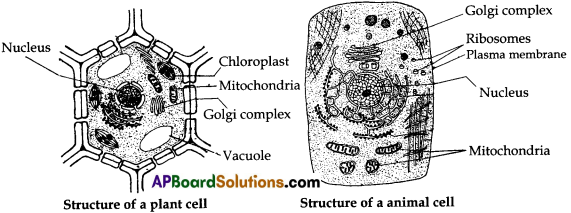
Question 10.
What questions will you pose to know diversity in cells?
Answer:
- Why are cells differentiated in different parts of the organism?
- Is diversity in cells lead to different functions?
- At what stage of cells influence diversity in their development?
- What is the importance of diversity in cells?
- How diversity in cells help the organism?
![]()
Question 11.
If you want to know about unicellular and multicellular organisms, what questions will you pose?
Answer:
- What is the difference between unicellular and multicellular organisms in terms of functions?
- Do unicellular and multicellular organisms possess similar functions?
- Are all the unicellular organisms having more life span like multicellular cellular organisms?
- Are all the unicellular organisms survive without specific organs unlike multicellular organisms?
- Explain the structure of unicellular organisms and compared to the organs of multicellular organisms.
Question 12.
Get some floating slime from a puddle, pick a very small amount of slime and put it on a slide. Separate out one fibre and look at it through the microscope. Draw the diagram of what you observed.
Answer:

Question 13.
Collect different kinds of leaves from your surroundings and observe the shapes of the epidermal cells under the microscope. Make a table containng serial number, name of the leaf, shape of the leaf, shape of the epidermal cells. Do not forget to write specific findings below the table.
| S.No. | Name of the Plant | Shape of the leaf | Shape of the epidermal cells | Remarks |
| 1. | Hibiscus rosa-sinensis (Mandara) | Wedge shape |
Rectangular | Stomatal cells are kidney shaped |
| 2. | Tridax procumbens (Gaddi chamanti) | Wedge shape | Rectangular | Stomatal cells are kidney shaped |
| 3. | Oryza sativa (Vari/Paddy) | Smooth | Rectangular | Stomatal cells are dumb-bell shaped |
| 4. | Saccharaum officinarum (Sugar cane) |
Smooth | Rectangular | Stomatal cells are dumb-bell shaped |
Question 14.
Make sketches of animal and plant cells which you observe under microscope.
Answer:

![]()
Question 15.
Ameer said “Bigger onion has larger cells when compared to the cells of smaller onions”! Will you agree with his statement or not’ Explain why.
Answer:
His statement is false as the size of the cells has no relation to the size of the onion. The cells of bigger onion and smaller onions are same in size. Only cells elongate and divide.
Question 16.
How do you appreciate the fact that animals, human beings and trees are made of cells, which are very small and we can look at them through microscope?
Answer:
The size of the cells has no relation to the size of the body of the animal or plant. It is not necessary that the cells in the animals be much bigger than those in a man. The size of the cell is related to its function. For example, nerve cells, both
in the animals and man, are long and branched. They perform the same function, that of transferring messages.
Question 17.
Deepak said, “A plant can’t stand erect without cell wall”? Support this statement?
Answer:
- Cell wall provides strength and rigidity to the plants.
- When the plants are watered cells absorb water and swell. As the cell wall is tough and hard, it prevents excess swelling of the cell.
- Hence, without cell wall plants can not stand erect.
TS 8th Class Biology 2nd Lesson Cell: The Basic Unit of Life Intext Questions
Question 1.
All living organisms carry out certain basic functions. Can you list these functions?
Answer:
All living organisms carry out certain basic functions like growth, reproduction and metabolism.
![]()
Question 2.
What is the basic structural unit of an organism?
Answer:
Basic structural unit of an organism is ‘Cell’.
TS 8th Class Biology 2nd Lesson Cell: The Basic Unit of Life Activities
Activity – 1 : Observing a match stick:
Question 1.
Take a match stick, soak it for half an hour and cut thin slices of it. Select a thin slice and place it on a slide. Put a drop of water and cover it with a cover slip, without allowing air bubbles and observe it under a microscope. Draw the figure of what you have observed. Compare your figure with (Fig-2). Are they similar or is there any difference? What are these rectangular shaped structures called? Have you noticed the rectangular structure?
Answer:
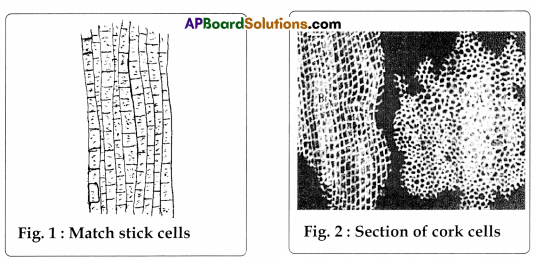
Rectangular shaped structures are noticed in the slice.
Both figures are similar and these rectangular structures are called Cells.
Question 2.
Like the dead cells, can we also see living cells under the microscope? so, how? Will their structure be the same as those of dead cells?
Answer:
1. Like dead cells we are able to see living cells under the microscope.
2. We can observe the living cells under the microscope by preparing a slide of onion peel.
Procedure : Take an onion bulb. Remove the dry pink coverings (peels). Separate these from the fleshy white layers of the bulb with the help of forceps. Place a small piece of the thin onion peel in a drop of water on a glass slide. The thin layer can be cut into smaller pieces with the help of a blade or forceps. Add a drop of water to the layer and place a coverslip on it. While placing the coverslip ensure that there are no air bubbles under the coverslip. Observe the slide under the microscope. We can find the living cells of onion peel.
3. The living cells that were observed under the microscope are different from dead cells. We observed a dark circular spot (nucleus) in the living cells of onion peel in the above mentioned activity, but dead cells are devoid of nucleus and other cell organdies.
![]()
Activity – 2 : Observing an onion peel:
Question 3.
Peel an onion and cut out a small fleshy portion from the bulb (fig. 3a). Break this piece into two small parts and try to separate them (fig. 3b). You will notice a thin translucent film holding the pieces together. Take out the film (membrane), cut a small piece from it and spread it evenly in a drop of water on a slide. While placing the peel on the slide, make sure that it is not folded. Cover it with a cover slip and observe it under the microscope. Draw the figure of what you have observed. Compare your figure with fig 4 in the lesson. Are there any differences between these two figures? If so, what are these differences? (Experiment)
Answer:
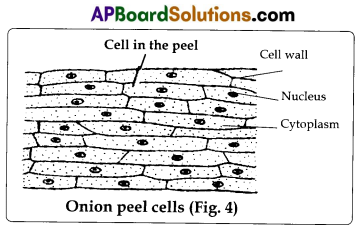
Both the figures are same. There is no difference between the drawn out figure and the figure 4 in the lesson.
Activity- 3 : Observing human cheek cells:
Question 4.
Take a clean wooden or plastic spoon and scrape the inner surface of your cheek. Now take the scrapping that you have collected, and place it in a drop of water taken on a slide. Cover the slide with cover slip. Observe the slide under the microscope. Draw the figure of what you have observed. The cell that you see would be very similar to those shown in Fig-5. Is the outer covering of both cells similar?
Answer:

The above drawn out figure is similar to the figure 5. The outer covering is similar in both the cells.
Activity – 4: Observation of the Nucleus in onion peel cells:
Question 5.
Peel a membrane of an onion once again. Now keep this membrane on a slide and add 1-2 drops of the stain (saffranin, methylene blue or red ink). Now observe this slide under a microscope. (Experiment)
Answer:
We can observe dark circular spots in the cells. These circular spots are nothing hut nuclei.
Activity – 5: Nucleus in cheek cells:
Question 6.
Compare the onion and the cheek cell. (Experiment)
A) What are the structures present in the cells?
B) Did you see a tiny dark stained thing in all cells?
C) Are they located in the centre of the cell in both cells?
D) What is the difference between boundary of on ion cell and cheek cell?
Answer:
A) Cytoplasm, nucleus, and cell organelles.
B) Yes, these are nothing but nuclei.
C) In cheek cells nuclei are present more or less at the centre of the cell, whereas in onion cells nuclei are not located in centre of cells, but towards the periphery.
D) The outer boundary in onion cells has cell wall, whereas in cheek cells it is made of membrane.
![]()
Activity – 6: Observing cells in a Leaf:
Question 7.
In onion peel cells you have seen that nearly all cells are similar in structure and shape. If you repeat this experiment with peels of onions of different size, what do you think your observations would be? Do bigger onions have big cells?
Answer:
The size of the cells has no relation with the size of the onion. Hence, cells in the onions are more or less similar in size.
Activity – 7:
Question 8.
Take a piece of grass leaf on the slide, put a drop of water, cover it with a cover slip and observe it under the microscope. Is your observation similar to the one given in fig-10 in the lesson. How many different types of cells or groups of cells could you see in the section?

- Both the figures are similar.
- I found two types of cells. They are rectangular epidermal cells and dumbbell shaped stomatal cells.
Activity – 8 :
Question 9.
Observe the given figures of human body cells. Draw the diagram of these and label the parts that you have learnt so far.
Answer:
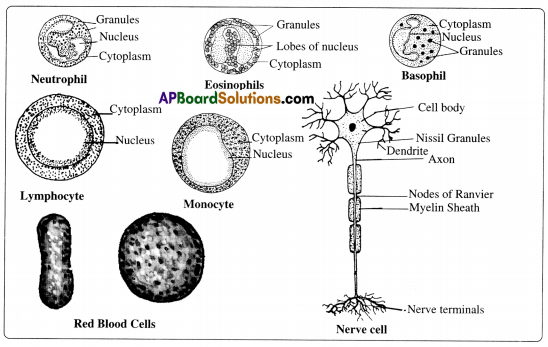
![]()
Question 10.
Fill the following table with the help of your teacher.
| S.No. | Name of the Cell | Shape of the Cell | Name the Parts observed in it |
| 1. | RBC | ||
| 2. | Muscle Cell | ||
| 3. | Nerve Cell | ||
| 4. | Bone Cell | ||
| 5. | White blood cell |
Answer:
| S.No. | Name of the Cell | Shape of the Cell | Name of the Parts observed in it |
| 1. | RBC | Round | Cell membrane, Cytoplasm |
| 2. | Muscle Cell | Spindle shaped | Cell membrane, Cytoplasm, Nucleus, Cell organelles. |
| 3. | Nerve Cell | Elongated | Cell membrane, Cytoplasm, Nucleus, Cell organelles. |
| 4. | Bone Cell | Star-shaped | Cell membrane, Cytoplasm, Nucleus, Cell organelles. |
| 5. | White blood cell | Round | Cell membrane, Cytoplasm, Lobed nucleus, Cell organelles. |
a. Are there any similarities in shape of the cells?
Answer:
Generally, cells are round, spherical or elongated. Some cells are long and pointed at both ends. They exhibit spindle shape. Cells sometimes are quite long. Some are elongated and branched like nerve cell or a neuron.
b. Do you find nuclei in all the cells?
Answer:
No, Red Blood Cells (RBC) are devoid of nuclei.
c. How do you define the shape of amoeba?
Answer:
The shape of amoeba appears irregular. Infact, amoeba has no definite shape, unlike other organisms. It keeps on changing its shape.
TS 8th Class Biology 2nd Lesson Cell: The Basic Unit of Life Important Questions
Question 1.
The basic structural unit of all organisms is called?
Answer:
Cell
Question 2.
Who discovered the cell?
Answer:
Robert Hooke
![]()
Question 3.
Who discovered the cell wall ?
Answer:
Robert Hooke
Question 4.
Who discovered the Nucleus ?
Answer:
Robert Brown
Question 5.
Give two examples for unicellular organisms.
Answer:
Bacteria, Amoeba, Chlaniydornonas.
Question 6.
Jelly like substance occupying the space between the cell membrane and the nucleus is called?
Answer:
Cytoplasm
Question 7.
Which part of cell contains cell organelles?
Answer:
Cytoplasm of the cell contains cell organelles. Cytoplasm is a jelly like substance occupying the space between the cell membrane and the nucleus.
Question 8.
Give examples of unicellular and multi cellular organisms.
Answer:
Unicellular organisms: Eg. Bacteria, Amoeba, Chiamydomonas etc.
Multicellular organisms: Eg. Most of the plants and animals.
Question 9.
What is one of the important differences between plant cell and animal cell?
Answer:
Plant cell differ from those of animals in having an additional layer around the cell membrane termed cell wall.
Question 10.
Name the identified part in the cell and mention its functions.
Answer:
The identified part is nucleus.

Functions of nucleus : Nucleus controls the function of all cell organdies.
Nucleus has genetic material that gives characters of organisms.
Question 11.
Write the procedure to observe the following cells in your laboratory.

Answer:
Peel an onion and cut out a small flesh’ portion from the bulb. Break this piece into two small parts and try to separate them. We will notice a thin translucent film holding the pieces together. Take out the film (membrane), cut a small piece from it and spread it evenly in a drop of water on a slide. While placing the peel on the slide, make sure that it is not folded. Cover it with a cover slip and observe it under the microscope.
![]()
Question 12.
Draw and label a neat diagram of Plant cell. What will happen if there is no cell wall?
Answer:
If cell wall is absent, plant cannot support their long and tall body. When the plants are watered, cells absorb water and swell. If the cell wall is absent, the swollen cell will burst and die.

Diagrams
Question 1.
Draw the diagram of Robert Hooke’s Microscope and label the parts.
Answer:

Question 2.
Draw the sketch of onion peel cells that you observed under microscope.
Answer:

Question 3.
You have prepared a slide of the check cells in the laboratory. Draw those check cells that you observed under microscope label the parts.
Answer:
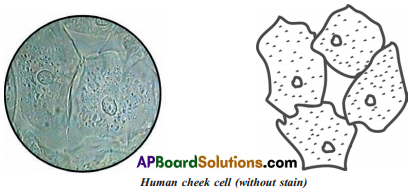
![]()
Question 4.
Draw the sketch of plant cells and onion cells that you observed in the slide.
Answer:

Question 5.
Draw the sketch of slide of check cells that you observed under microscope.
Answer:
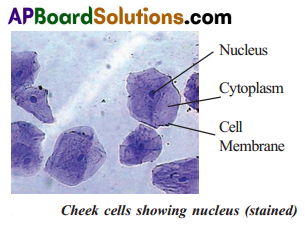
Question 6.
Draw a neat labelled diagram of amoeba.
Answer:
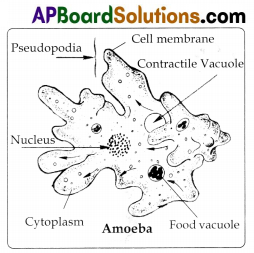
Question 7.
Draw the transverse section of Dicot stem.
Answer:
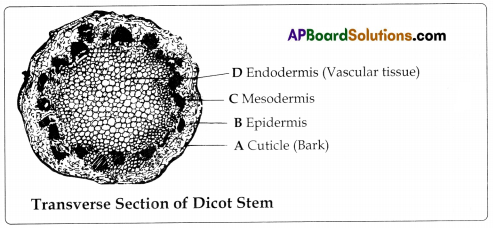
Question 8.
Draw the sketch of plant cells and onion cells that you observed in the slide.
Answer:
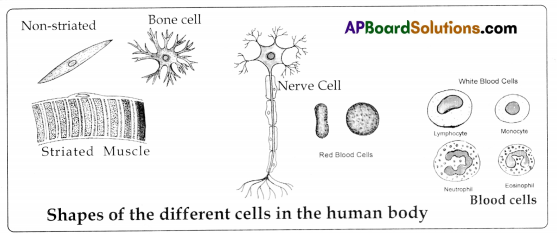
![]()
Question 9.
Fill the parts of given cells in the given blanks with appropriate labelling parts.
Answer:

A. Nucleus
B. Cytoplasm
C. Plasma membrane
D. Lysosome
E. Nucleus
F. Outer cell wall
G. Inner cell wall
H. Cytoplasm
I. Vacuole
Choose the correct answers :
Conceptual Understanding
Question 1.
Robert Brown discovered
A) Cell
B) Nucleus
C) Cell organdies
D) Bacteria
Answer:
B) Nucleus
Question 2.
Which of the following is not an unicellular organism?
A) Bacteria
B) Yeast
C) Amoeba
D) None of the above
Answer:
D) None of the above
![]()
Question 3.
The Structural and Functional units of the living body
A) cells
B) nuclei
C) cytoplasm
D) Vacuoles
Answer:
A) cells
Question 4.
The boundary of a cheek cell that you observe is ( )
A) cell wall
B) plasma lemma
C) cell membrane
D) tonoplant
Answer:
C) cell membrane
Question 5.
In Latin, “the cell” means
A) a part
B) small room
C) big membrane
D) cell membrane
Answer:
B) small room
Question 6.
Who observed the world of micro-organism for the first time?
A) William Harvey
B) John Swammerdam
C) Robert Hooke
D) Athenacious Kirchiqw
Answer:
A) William Harvey
Question 7.
Amoeba keeps on changing its shape for this cause
i) Locomotion
ii) Food
iii) Reproduction
iv) Respiration
A) i.
B) i, iii
C) i, iv
D) i, ii
Answer:
D) i, ii
![]()
Question 8.
List – A —- List – B
1) Cell wall ( ) a) controls cell
2) nucleus ( ) b) cell organelle
3) mitochondria ( ) c) provides shape
A) 1 – a, 2 – b, 3 – c
B) 1 – c, 2 – b, 3 – a
C) 1 – c, 2 – a, 3 – b
D) 1 – a, 2 – c, 3 – b
Answer:
C) 1 – c, 2 – a, 3 – b
Communication through drawing, model making
Question 9.
The figure represents a cell present in ( )

A) liver
B) muscle
C) bone
D) blood
Answer:
C) bone
Question 10.
Identify the neutrophil in the following figures ( )

Answer:
D)
![]()
Question 11.
One of the following does not belong to animal cell ( )
A) Cell membrane
B) Cytoplasm
C) Nucleus
D) Cell wall
Answer:
D) Cell wall
Question 12.
Cell is identified by Robert Hook, whereas nucleus by ( )
A) Robert Brown
B) Robert Down
C) Robinson
D) Ronald Ross
Answer:
A) Robert Brown
Question 13.
Among the following which is present in plant cell only ( )
A) Cell wall
B) Cell membrane
C) Chloroplast
D) A & C
Answer:
D) A & C
Question 14.
The shape of red blood corpuscles is ( )
A) Round
B) Star shape
C) Spindle
D) Ribbon
Answer:
C) Spindle
![]()
Question 15.
Stain used to observe bacteria under microscope ( )
A) Crystal violet
B) Methylene blue
C) lanus Green
D) All the above
Answer:
D) All the above